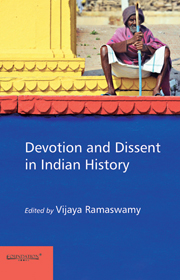Book contents
- Frontmatter
- Dedication
- Contents
- List of Tables and Figures
- Foreword
- Preface
- Introduction: Locating Devotion in Dissent and Dissent in Devotion A Thematic Overview
- Introduction
- 1 Parsing of Devotion and Dissent
- 2 Dissent and Protest in Early Indian Buddhism with Special Reference to Devadatta
- 3 Devotion and Dissent in Hunter's Bhakti
- 4 Devotion and Dissent
- 5 Dissent Within
- 6 Women in Love
- 7 Dissenting Voices
- 8 Dissent in Kabir and the Kabir Panth
- 9 Devotion and Dissent of Punjabi Dalit Sant Poets
- 10 Protest and Counter-protest
- 11 Fakirs of Bengal
- 12 Music in Chishti Sufism
- 13 Dissenting the Dominant
- 14 Devotion and Dissent within the Catholic Church in Late Colonial Bengal
- 15 Narratives of Travel, Voices of Dissent and Attacks on the Colonial Church Fabric of the European Missionaries
- 16 Devotion and Dissent in Narayana Guru
- 17 Sree Narayana Guru's Idioms of the Spiritual and the Worldly
- Contributors
- Index
10 - Protest and Counter-protest
from Introduction: Locating Devotion in Dissent and Dissent in Devotion A Thematic Overview
Published online by Cambridge University Press: 05 October 2014
- Frontmatter
- Dedication
- Contents
- List of Tables and Figures
- Foreword
- Preface
- Introduction: Locating Devotion in Dissent and Dissent in Devotion A Thematic Overview
- Introduction
- 1 Parsing of Devotion and Dissent
- 2 Dissent and Protest in Early Indian Buddhism with Special Reference to Devadatta
- 3 Devotion and Dissent in Hunter's Bhakti
- 4 Devotion and Dissent
- 5 Dissent Within
- 6 Women in Love
- 7 Dissenting Voices
- 8 Dissent in Kabir and the Kabir Panth
- 9 Devotion and Dissent of Punjabi Dalit Sant Poets
- 10 Protest and Counter-protest
- 11 Fakirs of Bengal
- 12 Music in Chishti Sufism
- 13 Dissenting the Dominant
- 14 Devotion and Dissent within the Catholic Church in Late Colonial Bengal
- 15 Narratives of Travel, Voices of Dissent and Attacks on the Colonial Church Fabric of the European Missionaries
- 16 Devotion and Dissent in Narayana Guru
- 17 Sree Narayana Guru's Idioms of the Spiritual and the Worldly
- Contributors
- Index
Summary
Historians are coming to terms with a comprehensive paradigm shift in early medieval India, which also has a bearing on the historiography of protest and revivalist movements. While there is an abundance of literature on the protest movements, and the dissidents as well, but the nature of protest, however, needs a critical review. This essay seeks to understand the process by which the ‘protest’ itself becomes dogmatic and therefore requires a protest and/or ‘reform’ to further revitalize the ‘tradition’. Moreover, the protest in itself needs a cogent qualification: for a question arises about the protest being aimed against whom/what? We shall ask this twofold question from the non-conformist North Indian Nath Siddhas over a long period, from the tenth to the sixteenth centuries, reflected in the waxing and waning of the movement, particularly in the Punjab. Also, we shall contextualize the protest against the changing profile of ascetic institutions and their nexus with the state; as much as against the dominant medieval perceptions impacting the language, norms and issues of devotion and worship.
O King! If you control the world,
We control spirituality.
You are worshipped by the rich and greedy,
We, by those who strive to remove illiteracy/
(We serve the knowledgeable).
If you have no faith in us,
We also have no sympathy for you!
The post-Gupta period in India is characterized by political fragmentation (particularly with the fall of the Palas, Pratiharas and Rashtrakutas), the crowning of the Puranic religion with profound impetus on temple activity – temple building, images and rituals – and the horizontal expansion of the ritually lower castes, the Shudras. The turbulence was such that the later Puranas predicted a systemic inversion, ‘the chiliastic image of total cataclysm’, whereby the Brāhmanas will behave like Shudras and the Shudras like Brāhmanas; the kings will become paupers and the paupers, kings; the servants as masters and masters like servants. That such an assertion was made at a time when the economy was being feudalized – declining trade, increase in land grants, declining towns and enhanced dependence upon agriculture – things must have been desperate, as the positional inversion within the power structure is inbuilt in this argument.
- Type
- Chapter
- Information
- Devotion and Dissent in Indian History , pp. 216 - 254Publisher: Foundation BooksPrint publication year: 2014



